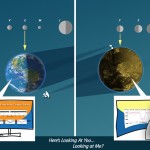W. M. Keck Observatory press release…
A team of scientists recently discovered a system of three planets, each just larger than Earth, orbiting a nearby star called EPIC 201367065. The three planets are 1.5-2 times the size of Earth. The outermost planet orbits on the edge of the so-called “habitable zone,” where the temperature may be just right for liquid water, believed necessary to support life, on the planet’s surface. The paper, “A Nearby M Star with Three Transiting Super-Earths Discovered by K2,” was submitted to the Astrophysical Journal today and is available here.

The planets were confirmed by the NASA Infrared Telescope Facility (IRTF) and the W. M. Keck Observatory in Hawaii as well as telescopes in California and Chile.
“Keck’s contribution to this discovery was vital,” said Andrew Howard, a University of Hawaii astronomer on the team. “The adaptive optics image from NIRC2 showed the star hosting these three planets is a single star, not a binary. It showed that the planets are real and not an artifact of some masquerading multi-star system.”
Due to the competitive state of planet finding, and the fact that time on the twin Keck telescopes are scheduled months in advance, the team asked UC Berkeley Astronomer, Imke de Pater to gather some data during her scheduled run.
“The collegiality of the Keck Observatory community is just wonderful,” Howard said. “Imke took time away from her own science observations to get us images of this system, all on a couple hours’ notice.”
The new discovery paves the way for studies of the atmosphere of a warm planet nearly the size of Earth.
“We’ve learned in the past year that planets the size and temperature of Earth are common in our Milky Way galaxy,” Howard said. “We also discovered some Earth-size planets that appear to be made of the same materials as our Earth, mostly rock and iron.”
The astronomers next hope to determine what elements are in the planets’ atmospheres. If these warm, nearly Earth-size planets have thick, hydrogen-rich atmospheres, there is not much chance for life.
“A thin atmosphere made of nitrogen and oxygen has allowed life to thrive on Earth. But nature is full of surprises. Many extrasolar planets discovered by the Kepler Mission are enveloped by thick, hydrogen-rich atmospheres that are probably incompatible with life as we know it,” said Ian Crossfield, the University of Arizona astronomer who led the study.
The discovery is all the more remarkable because Kepler is now hobbled by the loss of two reaction wheels that kept it pointing at a fixed spot in space. Kepler, launched in 2009, was reborn in 2014 as “K2” with a clever strategy of pointing the telescope in the plane of the Earth’s orbit to stabilize the spacecraft. Kepler is back to mining the cosmos for planets by searching for eclipses, or transits, as planets orbit in front of their host stars and periodically block some of the starlight.
“I was devastated when Kepler was crippled by a hardware failure,” Petigura added. “It’s a testament to the ingenuity of NASA engineers and scientists that Kepler can still do great science.”
Kepler sees only a small fraction of the planetary systems in its gaze, those with orbital planes aligned edge-on to our view from Earth. Planets with large orbital tilts are simply missed by Kepler.
“It’s remarkable that the Kepler telescope is now pointed in the ecliptic, the plane that Earth sweeps out as it orbits the Sun,” Fulton explains. “This means that some of the planets discovered by K2 will have orbits lined up with Earth’s, a celestial coincidence that allows Kepler to see the alien planets, and Kepler-like telescopes in those very planetary systems (if there are any) to discover Earth.”
“Here’s looking at you, looking at me,” said Howard.
In addition to Howard and Petigura, UH graduate students Benjamin Fulton and Kimberly Aller, and UH astronomer Michael Liu were among the two dozen scientists who contributed to the study.

